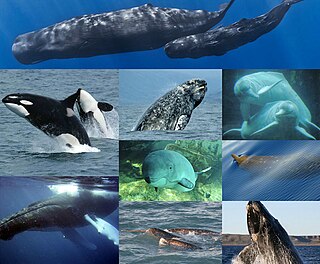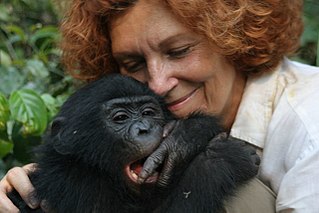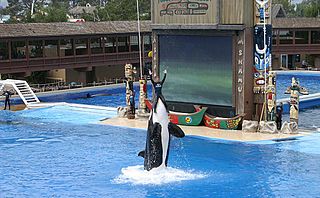
Cetacea is an infraorder of aquatic mammals belonging to the order Artiodactyla that includes whales, dolphins, and porpoises. Key characteristics are their fully aquatic lifestyle, streamlined body shape, often large size and exclusively carnivorous diet. They propel themselves through the water with powerful up-and-down movement of their tail which ends in a paddle-like fluke, using their flipper-shaped forelimbs to maneuver.

A dolphin is an aquatic mammal within the infraorder Cetacea. Dolphin species belong to the families Delphinidae, Platanistidae, Iniidae, Pontoporiidae, and possibly extinct Lipotidae. There are 40 extant species named as dolphins.

The orca, or killer whale, is a toothed whale that is the largest member of the oceanic dolphin family. It is the only extant species in the genus Orcinus. Orcas are recognizable by their black-and-white patterned body. A cosmopolitan species, orcas are found in diverse marine environments, from Arctic to Antarctic regions to tropical seas.

Whales are a widely distributed and diverse group of fully aquatic placental marine mammals. As an informal and colloquial grouping, they correspond to large members of the infraorder Cetacea, i.e. all cetaceans apart from dolphins and porpoises. Dolphins and porpoises may be considered whales from a formal, cladistic perspective. Whales, dolphins and porpoises belong to the order Cetartiodactyla, which consists of even-toed ungulates. Their closest non-cetacean living relatives are the hippopotamuses, from which they and other cetaceans diverged about 54 million years ago. The two parvorders of whales, baleen whales (Mysticeti) and toothed whales (Odontoceti), are thought to have had their last common ancestor around 34 million years ago. Mysticetes include four extant (living) families: Balaenopteridae, Balaenidae, Cetotheriidae, and Eschrichtiidae. Odontocetes include the Monodontidae, Physeteridae, Kogiidae, and Ziphiidae, as well as the six families of dolphins and porpoises which are not considered whales in the informal sense.

The beluga whale is an Arctic and sub-Arctic cetacean. It is one of two members of the family Monodontidae, along with the narwhal, and the only member of the genus Delphinapterus. It is also known as the white whale, as it is the only cetacean to regularly occur with this colour; the sea canary, due to its high-pitched calls; and the melonhead, though that more commonly refers to the melon-headed whale, which is an oceanic dolphin.

Whale watching is the practice of observing whales and dolphins (cetaceans) in their natural habitat. Whale watching is mostly a recreational activity, but it can also serve scientific and/or educational purposes. A study prepared for International Fund for Animal Welfare in 2009 estimated that 13 million people went whale watching globally in 2008. Whale watching generates $2.1 billion per annum in tourism revenue worldwide, employing around 13,000 workers. The size and rapid growth of the industry has led to complex and continuing debates with the whaling industry about the best use of whales as a natural resource.

Oceanic dolphins or Delphinidae are a widely distributed family of dolphins that live in the sea. Close to forty extant species are recognised. They include several big species whose common names contain "whale" rather than "dolphin", such as the Globicephalinae. Delphinidae is a family within the superfamily Delphinoidea, which also includes the porpoises (Phocoenidae) and the Monodontidae. River dolphins are relatives of the Delphinoidea.

The toothed whales are a parvorder of cetaceans that includes dolphins, porpoises, and all other whales possessing teeth, such as the beaked whales and sperm whales. 73 species of toothed whales are described. They are one of two living groups of cetaceans, the other being the baleen whales (Mysticeti), which have baleen instead of teeth. The two groups are thought to have diverged around 34 million years ago (mya).

Cetacean intelligence is the overall intelligence and derived cognitive ability of aquatic mammals belonging in the infraorder Cetacea (cetaceans), including baleen whales, porpoises, and dolphins.

Orcinus is a genus of Delphinidae, the family of carnivorous marine mammals known as dolphins. It includes the largest delphinid species, Orcinus orca, known as the orca or killer whale. Two extinct species are recognised, Orcinus paleorca and O. citoniensis, describing fossilised remains of the genus. The other extinct species O. meyeri is disputed.

Whales use a variety of sounds for communication and sensation. The mechanisms used to produce sound vary from one family of cetaceans to another. Marine mammals, including whales, dolphins, and porpoises, are much more dependent on sound than land mammals due to the limited effectiveness of other senses in water. Sight is less effective for marine mammals because of the particulate way in which the ocean scatters light. Smell is also limited, as molecules diffuse more slowly in water than in air, which makes smelling less effective. However, the speed of sound is roughly four times greater in water than in the atmosphere at sea level. As sea mammals are so dependent on hearing to communicate and feed, environmentalists and cetologists are concerned that they are being harmed by the increased ambient noise in the world's oceans caused by ships, sonar and marine seismic surveys.

A dolphinarium is an aquarium for dolphins. The dolphins are usually kept in a pool, though occasionally they may be kept in pens in the open sea, either for research or public performances. Some dolphinariums consist of one pool where dolphins perform for the public, others are part of larger parks, such as marine mammal parks, zoos or theme parks, with other animals and attractions as well.

The Vancouver Aquarium is a public aquarium located in Stanley Park in Vancouver, British Columbia, Canada. In addition to being a major tourist attraction for Vancouver, the aquarium is a centre for marine research, ocean literacy education, climate activism, conservation and marine animal rehabilitation.

A waterphone is a type of inharmonic acoustic tuned idiophone consisting of a stainless steel resonator bowl or pan with a cylindrical neck and bronze rods of different lengths and diameters around the rim of the bowl. The resonator may contain a small amount of water giving the waterphone a vibrant ethereal sound that has appeared in movie soundtracks, record albums, and live performances. The instrument was invented, developed, and manufactured by American Richard Waters (1935–2013).

Marineland, is a themed zoo and amusement park in Niagara Falls, Ontario, Canada. The park has performing marine animal shows, exhibits of marine and land animals, and amusement rides. It keeps dolphins, sea lions, and beluga whales. Until 2023, the park also kept walruses and orcas. The park also keeps bears, deer, and other land animals. It was founded and operated by John Holer, a Slovenian immigrant, from 1961 until his death in 2018. It is privately owned and operated by his family.

Human–animal communication is the communication observed between humans and other animals, ranging from non-verbal cues and vocalizations to the use of language.

An animal sanctuary is a facility where animals are brought to live and to be protected for the rest of their lives. Pattrice Jones, co-founder of VINE Sanctuary defines an animal sanctuary as "a safe-enough place or relationship within the continuing hazards that menace everybody". In addition, sanctuaries are an experimental staging ground for transformative human–animal relations. There are five types of animal sanctuaries reflective of the species-belonging of the residents: 1) companion animal sanctuaries; 2) wildlife sanctuaries; 3) exotic animal sanctuaries; 4) farmed animal sanctuaries; and 5) cetacean sanctuaries.

A marine mammal park is a commercial theme park or aquarium where marine mammals such as dolphins, beluga whales and sea lions are kept within water tanks and displayed to the public in special shows. A marine mammal park is more elaborate than a dolphinarium, because it also features other marine mammals and offers additional entertainment attractions. It is thus seen as a combination of a public aquarium and an amusement park. Marine mammal parks are different from marine parks, which include natural reserves and marine wildlife sanctuaries such as coral reefs, particularly in Australia.
A talking animal or speaking animal is any non-human animal that can produce sounds or gestures resembling those of a human language. Several species or groups of animals have developed forms of communication which superficially resemble verbal language, however, these usually are not considered a language because they lack one or more of the defining characteristics, e.g. grammar, syntax, recursion, and displacement. Researchers have been successful in teaching some animals to make gestures similar to sign language, although whether this should be considered a language has been disputed.

Chimelong Ocean Kingdom is a theme park situated in Hengqin, Zhuhai, People's Republic of China. It was designed by PGAV Destinations. The park broke ground on November 28, 2010 and soft-opened on January 28, 2014. The grand opening occurred on March 29 of that year. The first phase of the park cost RMB 10 billion to build. It is part of the Chimelong International Ocean Tourist Resort, which aims to become the "Orlando of China". According to TEA and AECOM, it was the 10th most visited theme park in the world in 2018, with 10.83 million visitors.

















